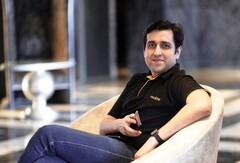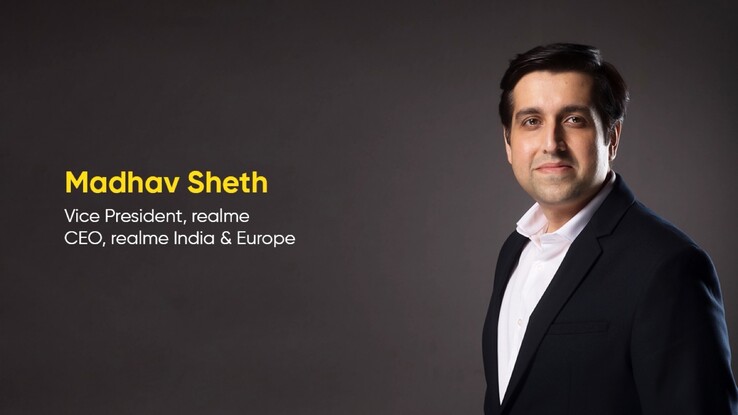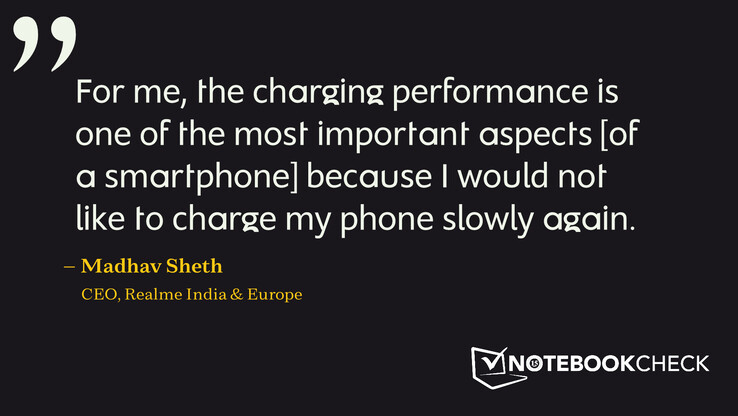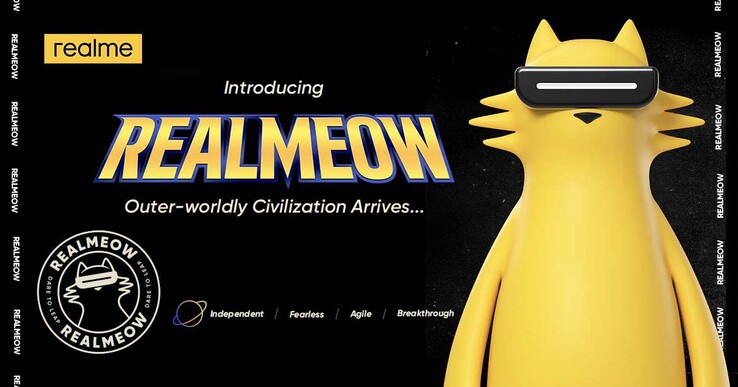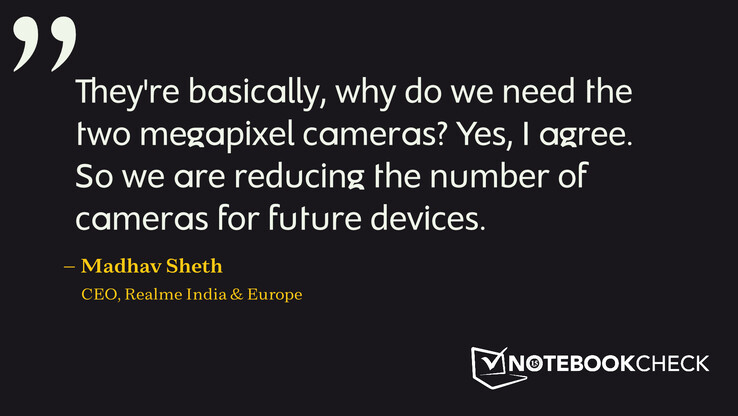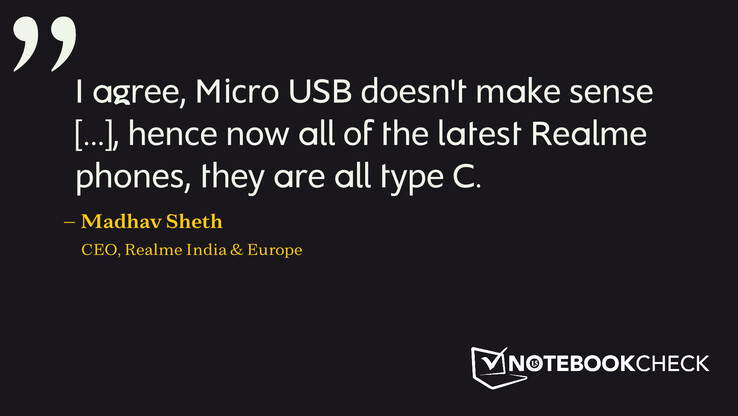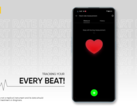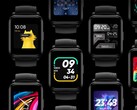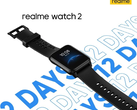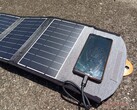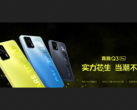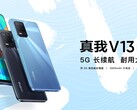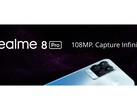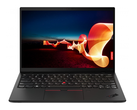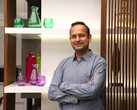Realme has seen incredible success since the company started selling smartphones in 2018. Now, we got a chance to talk with Madhav Sheth, the CEO of Realme India & Europe. Based in Mumbai, India, and born in 1981, he is responsible for the brand's strategy in two of the world's largest smartphone markets. During our interview, he commented on a lot of topics consumers will be wondering about, so let's get started.
Hannes: Thanks for taking the time to talk to us today, Madhav! Since not all of our readers are aware of Realme yet, could you please tell us what your brand does, and why consumers should be aware of Realme?
Madhav: Okay. So we started the journey back in 2018. We started from India. Now, we are present in more than 61 markets. We are among the top four manufacturers. And yes, we do share some of the resources with our parent companies, which are Oppo and OnePlus. We do share some resources with Oppo, but yes, we are a completely independent brand. The only connection that we had was Mr. Sky Li; he was working over there for the past 17 years as a chairman. And basically it's a group CEO for us, for Realme globally. I'm managing the countries for India and the European region. And most of the countries where we are present, we are among the top five players as of now.
So there is defiance, the reason behind saying this, this defines the speed. Realme currently is one of the seven largest smartphone brands in the world, and the fastest-growing smartphone brand in the world for the last seven or eight quarters. Even last year, we grew by around 67% year on year. We were the only brand who grew by 67% and none of the other brands, I think apart from one brand that grew by two digits, none of the other brands grew during this COVID time. So I think that also defines the way the economy is growing faster, answering your question on why Realme has to be on the consideration set of any of the buyers? Because Realme is not just a smartphone brand, Realme is coming to the countries with a bigger vision of having lifestyle products and a complete ecosystem of products, where the smartphone is just a hub to connect all these ecosystem devices.
So Realme will be into smart homes, smart life, tech life, and a host of ecosystem products. We are already into TVs and after launching our product successfully for smartphones, we'll also be launching smart home products, even in the European markets. So we all are connected to our Realme Link app. And this is also available not only for Android, but also for iOS users, so they can also experience our products and they can also understand how Realme Link app works or how the Realme products work. Yes, there's a lot of room to improve and, as we are growing very fast, we are a community-driven brand. Our go to market time is much faster than any other brand because our need and our understanding of the market is much faster than any of the other brands. Hence, I believe this was one of the biggest reasons why we grew so much.
Hannes: Your growth in Europe was especially stunning last year. I've seen data from Counterpoint Research indicating that you sold, I think, just 0.1 million smartphones in 2019, but then 1.6 million in 2020. Do you think you can keep growing at this rate in Europe?
Madhav: Yes, I think we can and we'll be growing much faster than that speed. And that's what I assume this year. My target is to grow to around 10 to 15 million devices in sales in smartphones. So that's for my EU plan. But definitely I think we will be growing at a much faster pace and we can see the market opportunities. Also the reason in order to support the vacuum created by other brands.
See, there's a thin line difference between offering cheaper phones and offering a value for money phone, so Realme believes in offering value for money. So Realme, a full-fledged brand, starting from entry-level smartphones, going up to the highest end smartphones and creating value at every single price segment, wherever they'll be offered. So I think that's what Realme is all about.
Hannes: Sky Li said last July that you want to sell 100 million smartphones by 2023. So I think this is still pretty realistic, isn't it?
Madhav: It is realistic because I think this year itself, we are targeting nothing less than 65 to 70 million handsets. So I think 2023, maybe, you know, our aspiration was a hundred million, but maybe we should be crossing that as well.
Hannes: The smartphone market is probably the most competitive market in the world right now. And Realme only started out in 2018 if I'm not mistaken, with the Realme 1 in May. So what's your secret? How did you become one of the leading smartphone brands in just three years?
Madhav: It's very simple, right? It doesn't require too much logic. It's very simple to be heard by your users. So there are three things, you know, but I think we do not have to complicate things. First of all, whenever people ask me, I say it's very simple. B, think about the user and the benefits that the user can get at every single price point. If I'm able to deliver these two things this becomes very easy, because if I don't keep things simple, I have my team who has to execute the things on the ground. If I don't keep things simple, they will make things more complicated on the ground. So first is we keep it very simple. Secondary is make sure that basically the user understands what I'm trying to offer at every single price point. If I'm able to deliver this message to the users at the right time at the right price, then I'm done. I think that's it, that's the whole thing.
Hannes: At the moment, I think you agree that consumers are looking mostly for high quality cameras, big batteries and fast screens. What do you think will be the trends in the smartphone industry in the next two to three years?
Madhav: Yes, I would, as I was saying to one of the previous interviews that basically for me, the charging performance is one of the most important aspects because I would not like to charge my phone slowly again. Hence, for me, charging performance matters, for some cameras matter. So Realme is an all-rounder phone. So the Realme 8 Pro is an all-rounder phone with 50 watt fast charging, 108 megapixel camera, with an option of having lots of digital lens options available on your phone.
For example, for a lot of photography enthusiasts now, because of social media and the digital world, a lot of millennials would love to experience digital lenses, even on the smartphone. So Realme for the first time has brought tilt shift photography on smartphones, and that's never been done before in any other smartphone. This is just one point of differentiation, but there are hundreds and thousands of filters. So you do not have to have a third party app to get your filters on. You're gonna use the inbuilt filters and a lot of digital lenses to explore different parts of photography. And that's what Realme is all about.
Hannes: Yeah, we will get back to the 108 megapixel sensor in the Realme 8 Pro a little later. But let me just first ask a quick question about the production issues, because there are lots of reports that, for example, Qualcomm can't provide enough Snapdragon chips for individual manufacturers and prices are rising. Does Realme already feel any impact from these issues?
Madhav: See, supply chain disruption was, I think, an industry phenomenon. I know it's a universal phenomenon because of a lot of reasons of the lockdowns and a lot of what is getting closed. So it was a universal phenomena and we were a part of that particular thing. Yes. How soon you recover from this particular phenomenon, that is something that depends on the brand. I think Realme has been very fast and agile to recover from this particular situation. So yes, we are recovered 90% from the supply chain disruptions, but at the same point of time, though prices are rising, I would believe that we are trying to bring a lot of 5G chipsets to our most affordable and economical price points.
So now we will be one of the first ones to bring the Dimensity chipset range to Europe. Dimensity 700, 800, or Dimensity 1000 or 1200. We will be the first one to bring all these chips. So we are trying to bring all of this at the most affordable price where people can enjoy 5G at a most democratized price. And that's what is also one of our visions for this year to democratize 5G at different price points.
Hannes: 5G is still not available everywhere. So do you think that it's already driving upgrade cycles, so consumers are upgrading faster because they want a 5G phone, or is it just that if you're going to upgrade anyway, you buy a 5G phone because you want to future proof it?
Madhav: That's one of the reasons, yes, you want to be future proof because the replacement cycles are normally 12 to 18 months. And because of COVID, maybe it may be increased, but yes, it's 12 to 18 months where I can see the replacement cycles happening for the young populations. There's one more aspect to it, which I would always like to highlight to my users. 5G chipsets are just about the network, take 5G as an icing on the cake. But 5G chips bring a lot of the latest developments, which all the manufacturers are doing it, which they are not doing on 4G, because the future is about 5G.
It may be touch response. It may be performance. It may be GPU, CPU, with all those things you can see the biggest optimization happening on 5G chipsets. 5G chipsets will improve your touch response. They will improve the battery optimization. They will improve your camera stability. They will improve your speed. So 5G chips are not just about the 5G services, but bring a host of performance features.
Hannes: Let's just quickly talk about an entirely different topic, because Realme is not just about the product. It's also about the brand. And you've done some really interesting things like Realmeow, your mascot. How did consumers react to it and do you have any future plans with Realmeow?
Madhav: See, it's more about connecting with the user because that's the Realme mascot. We believe that basically, a cat being an agile animal, I think, we just want it to be more connected to the users in different ways. So, as I said, our mascot being Realmeow, we are just trying to ensure that basically people get a brand message delivered to them in the simplest and the easiest language, which they understand in the millennial language.
Hannes: I think it's time to talk a little bit about your products. So the Realme 8 Pro is your first phone with a 108 megapixel sensor. It uses a Samsung Isocell HM2, if I'm not mistaken. Is there a specific reason why you chose this sensor? Because there are multiple 108 megapixel sensors available right now.
Madhav: A lot of people have asked me why didn't you use the HM3. We all need to understand that HM3 has just been launched and to develop that particular thing will take some amount of time for us. We were working with Samsung for this product from the development stage. So since its beginning. And this sensor is being widely used in the industry at this point. We went with HM2 because it was already in development in the initial stages.
Hannes: We do have some photography enthusiasts among our readers who wanted to know if it's possible to save 108-megapixel RAW files from the Realme 8 Pro?
Madhav: You can get the RAW files from 108 MP camera, for sure.
Hannes: Instead of a dedicated telephoto camera, you introduced new in-sensor zoom technology. Do you think it actually delivers better quality than say a 12-megapixel 3x optical zoom?
Madhav: Yes. I think you can get the best results of smartphones. That's what I can say.
Hannes: You have to use smaller sensors in tele cameras most of the time, right? So, in the end you got a similar sensor size if you cropped in from a bigger sensor.
Madhav: So we have a lot of feedback on the number of our cameras, about three cameras. They're basically, why do we need the two-megapixel cameras? Yes, I agree. So we are reducing the number of cameras for future devices. We are just focusing on more wide angles or more on the telephoto, or we are doing a lot of surveys with the consumers right now to understand what will be the important lenses.
There are other things we'll definitely try to optimize through the software. So I believe that basically even one camera can do wonders and even two cameras can do wonders, but it depends because we have a lot of millennial population and, I would say not a digital population who want to have different types of lenses in their cameras because of their social media-ready photographs. They are looking for it. So, hence we tried doing that, but yes, we are going to over a period of time, we've got a lot of feedback from the European markets, and basically we can go away with few of the lenses, and use software tunings to get that particular similar type of results.
Hannes: I've got some questions from our readers which are more general about your smartphones. For example, I think almost none of your smartphones have wireless charging, if any, is there a specific reason why? Because in Europe, there are definitely a lot of people who are missing wireless charging functionality.
Madhav: Nothing has happened because basically what we have seen in wireless charging solutions is they are not that much faster than basically the wired charging solutions, because you still need the wire to the wireless charger. So you need to plug in the wireless charger and put the phone on the wireless charger. I wanted to give a more practical solution to it, wirelessly charging your phone takes maybe two or three hours wherein if you use either the 65 watt or the 50 watt charging solution, in 47 minutes your entire phone has been charged. So we wanted more practical solutions to it. I'm not saying that I'm against wireless charging, but yes, I love wireless charging technology, but only if it gives you the same experience as wired charging.
Hannes: Okay. So we can expect wireless charging once the technology is faster and more convenient than it is now?
Madhav: No, I think giving you a wireless charging solution to charge your phone does not make sense. So we have to be more practical, rather than, you know, just giving you something, which is just there, but no-one uses it.
Hannes: Yeah. I guess that's true. There are some users who like to charge their phones overnight, where it doesn't really matter how long it takes, though.
Madhav: I believe that basically, with a 65 watt charging solution, you will never like to go back to your normal charging solutions. Because once you use 60 watt, that's so addictive that it basically charges your phone within about 30 or 40 minutes. So wireless charging is completely out of question after that.
Hannes: Another thing which our readers really like and phone manufacturers don't always like is a headphone jack, the 3.5 mm one. Do you think it will still be there in the future or will it be completely gone in a year or two?
Madhav: I think type C will definitely replace the 3.5 mm jack, but I believe there are still users who love to have the 3.5 mm jack and we are constantly, I think, working on the solution. So if you see a 200- or 250-Euro phone, we'll always have the 3.5 mm jack. Around 250 or 300 Euros, we always try to go for type C and we try to give type C cable along with the phones. So, yeah, we're looking into that.
Hannes: So, another topic which you already touched briefly on: Most smartphones have a triple or quad camera at the moment, but, especially at the lower end, two or even three of the sensors are like two-megapixel sensors for specialized tasks. Why do you use them? I don't think people actually use those sensors, do they?
Madhav: I agree. Hence if you see a lot of phones in the future which would have only two or three lenses and not four cameras, but consumers have different requests in different scenes. So we try to fix it because a lot of our community users are millennial populations and they want to experience different lenses before they actually started using digital cameras. And that was the purpose of having the three or four lenses on the phones. But if you see now we're starting with our X7 or X7 Pro, you will be seeing the number of lenses has been reduced to three or two. So that's what you'll see.
Hannes: At the moment, if you look at a smartphone, you can tell its price by the size of the chin under its display. That's just for cost reasons, right? It doesn't have any design specific reasons, it's just because displays with larger chins are cheaper?
Madhav: It's just a design philosophy sometimes because right now this year, we have made a vision to have a very thin and slim phone. So Realme 8 Pro is just about 175 grams. It's super slim for the fastest charging solutions with 4,500 mAh battery. So if you see the phone fits in perfectly within any of the pocket, and it feels so light. So I think it's just a design philosophy and nothing else.
Hannes: One thing that people hate about the cheapest smartphones is that they still use micro USB ports sometimes. It shouldn't cost a lot more to put a USB-C port in there?
Madhav: I agree because I think all the cables nearby you are all type C, so micro USB doesn't make sense and I pretty much agree to it. And hence if you see now all of the latest Realme phones, they are all type C.
Hannes: Apart from smartphones, Realme also offers smartwatches, wireless headphones, and home security cameras. Can we expect Realme to enter different product categories in the near future?
Madhav: Yes. We are already into a lot of ERD products like TWS, we are already into wearables, like smartwatches, smart bands, and Realme will launch smart home categories, like smart TVs, also in the European market. So you can see smart audio wearables and smart TVs coming soon to Europe.
Hannes: Since you are selling both a round and a square smartwatch, which do you prefer?
Madhav: A round one because I'm still a traditional watch user. So it gives me a feeling of a traditional watch at the same time.
Hannes: The third and most difficult part of the interview is about the right to repair and environment because the right to repair movement gained a lot of traction in the last few years. So what's your stance on consumers being able to repair their own device?
Madhav: First of all, I think Realme has always provided all its products and services in a responsible manner. We abide by all the laws and regulations and the policy guidance on the ecological environment protection. But I would say that Realme's rate of returns has always been low at less than 0.4%. So I would say Realme has got all the documentation and the registration certificates for all the environmental permits, and also fulfills all the environmental protection responsibilities.
So I think, yes, we do all the things which are required by the laws of the countries. At the same point of time, you may also ask about our carbon footprints and on the devices, Realme smartphone equipment I think meets all the EU's COC energy efficiency standards, which aims to solve the increasingly tense energy crisis and alleviate the pressure of the global greenhouse effect.
Hannes: So, say I buy a Realme 8 and the screen breaks because I drop it, and I want to replace the screen myself. Is there any way for me as a consumer to get a replacement screen?
Madhav: As of now it is not BYOD, is not build your own now or, you know, do it yourself. It's not like that. It's not possible as of now, but we have an efficient and stable after-sales service, which is very convenient. We have focused on quality and we have also provided a convenient, fast and trustable after sales service. Currently we do not do the self-repairing I think I can say. But yes, we are working on evaluating on that particular part as well.
Hannes: Okay. So is repairability a focus when you develop a new product, because it also makes it easier to repair devices at your own factories. Right?
Madhav: We've been getting a lot of requests lately. And I think we are starting to think on this particular part as well, but as of now, yes, we have already service centers and a very efficient 360-degree software service repair system. So we've been getting requests. So yes, in the future, we'll definitely evaluate that.
Hannes: Another part of smartphone longevity is software support, and it's still kind of hard for consumers to see if they buy a new smartphone. How long will they get the newest Android updates, how long will they be able to use it before the software is outdated. So, how can buyers of the Realme 8 Pro expect to be supported by software updates and how long do you generally support your phones?
Madhav: I want you to google and check in wherever the countries we've been operating because, you know, brands can claim big, but they cannot deliver. Brands can claim that they can give three years, four years of Android updates, but do they really deliver, that's something that's always questionable. So that's our commitment and what Realme has always delivered, that basically Realme has been fastest in giving the updates. It may be monthly or bi-monthly updates. We have always shared security patch updates on a bi-monthly basis to our devices as promised. At the same point of time, we have always committed that basically we will be giving two Android updates to all our users and we stand by our commitments to date.
Hannes: You already touched briefly on it. Can you just tell us if Realme has any specific environmental goals to reach by 2025, 2030, something like that, or is there nothing to share?
Madhav: Not really, right now we are just following the compliance and the laws. Our goal is right now just to ensure that basically our users understand the brand better.
Hannes: When Apple started shipping phones without chargers and headphones, people really didn't like it. So, their reason was to protect the environment, but consumers didn't buy it. So what are your plans, do you plan to keep shipping your phones with chargers?
Madhav: As of now Realme doesn't think of doing that. See, I would say they are not wrong because they have a huge user base and their chargers are enough in the market, so they can always think of it. But as Realme as a brand, our user base is quite smaller. So we cannot tell our users to just buy the device and hunt for the chargers separately. So I would not even think of doing it in the nearest future. So yes, basically, as I said, it's a different perspective at the different brand levels. So for Realme the user base is so small, we cannot think of doing it. We are giving a faster charging technology and that chargers are not available in the market. So that has to be combined with a phone to be given to the users.
Hannes: True, with fast charging standards, it's a little more difficult to get a charger as well.
Madhav: So if I don't give you our 65 watt charging solution, it's like if I'm giving you a car with a capacity of 600 nanometer of NMR in the tank, but I do not give you the fuel to do it. Right. So what's the point of doing that? If I'm giving you a 65 watt charging solution on a phone, and I'm only giving you a 10 watt charger, there's no point. It's better to give you a 60 watt charging solution along with the phone. So I think the user's peace of mind is extremely important.
Hannes: Yeah, because most users wouldn't buy an expensive charger in addition to their phone. So they would just be stuck with 10 watt charging.
Madhav: I always believe that basically, price should not define the premium-ness of the phone, but the specs and what it delivers, and the technology that it gives you at that particular price that should deliver the premium-ness of the phone and not the prices. A technology should never be defined by the price.
Hannes: That's a good point to end on, I would say. So could you just give us any hint on what we can expect from Realme in the next few months?
Madhav: Products you can see at affordable prices, at value for money prices, a lot of ecosystem products, which we are going to launch maybe along with TWS also. Yes. So I think that's pretty much what we are going to bring.
Hannes: Yeah. Well, it was my pleasure. Thank you so much for taking your time out of your stressful day after all these launches.
Madhav: Thank you very much.
Source(s)
Realme




